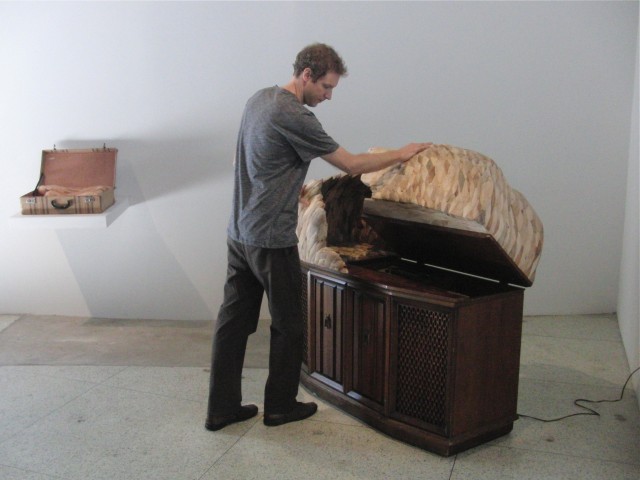
Thomas Beale prepares for a bit of delirium as innovative Honey Space gets ready for farewell to Chelsea (photo by twi-ny/mdr)
HONEY SPACE
Honey Space
148 Eleventh Ave. between 21st & 22nd Sts.
Through September 29, free, 10:00 am – 6:00 pm
www.honey-space.com
Five years ago, we were strolling rather aimlessly through Chelsea galleries when we came upon an odd sight on Eleventh Ave. In what looked like an abandoned warehouse with its metal gate up, a man’s head was popping up from under the floor, his noggin surrounded by biomorphic wooden sculptures. With the traffic passing by on the West Side Highway, we ventured in and met Dartmouth graduate Thomas Beale, an artist who was taking over the eight-hundred-square-foot space on a temporary basis for free, courtesy of real estate developer Alf Naman, who was allowing Beale to do anything he wanted with it as long as he served as a kind of maintenance man for the building. The friendly Beale talked about his plans for the gallery and discussed his work, intriguing sculptures made from found wood and shells. “Temporary” ended up being more than five years, during which Beale put on a series a fascinating shows, many with interactive performance elements, each time dramatically changing the space. He also often left the door/gate wide open, with no one minding the store, allowing people to come and go without supervision — and without incident.
Visitors were invited to enter Daphane Park’s “Superconductor” and investigate their consciousness, have a drink in Mickey Western’s “Gringolandia” and ask Western to play a song, share their secrets with a pair of scantily clad women for Inner Course’s “Panties for Diamonds,” or climb a ladder down into Jane Watson and Swoon’s haunting “Portrait of Silvia Elena,” which examined the string of rapes and murders of young girls and women that continues in Juarez, Mexico. Beale is now saying farewell to Honey Space with one final exhibit, which he is simply titling “Honey Space,” featuring his own works, including “Delirium,” an old stereo console topped with a dome of found wood, “Gift,” a hat box with found wood emerging from it like a balloon, and a field of living grass with various objects on it, most prominently the shimmering “Skyglass,” made of reclaimed temple wood and Japanese lacquer. As he prepared for Honey Space’s final days — there will be a “Feast of Friends” celebration Thursday night from 8:00 to 12 midnight with performances by Mesiko, Behavior, Mickey Western, and DJ Hahaha — Beale took a few minutes to look back on his time there and consider what comes next.
twi-ny: In your announcement of this final exhibition, you express “supreme pleasure.” Surely there’s at least a twinge of sadness at leaving, no?
Thomas Beale: Without a doubt. It’s a major transition, and my years in this building, and operating Honey Space, have been a once-in-a-lifetime experience. Nonetheless, I was originally offered a year and a half to two years in this building, which has become more than six. I always hoped to end the experience of Honey Space with an exhibition of my own work, and I was able to do that. So I leave with few regrets. . . . Really, the feeling that I was offered more than I ever dreamed of, and I did the absolute maximum with it.
twi-ny: Do you have a favorite memory or two that occurred inside Honey Space?
Thomas Beale: Mickey Western’s “Gringolandia” was an experience like none other. The closing party was the peak, not only of that exhibition, but of the arc of Honey Space itself. It was early November 2008, the economic crash had just happened, everyone was reeling and trying to figure out what the new world was going to look like, it was nineteen degrees outside, and there were two hundred people packed inside an eight-hundred-square-foot space covered in tin foil, blinking lights, a circular stage, an illegal bar . . . literally packed, shoulder to shoulder, like sardines. One of the bands playing that night, a nine-piece brass band from New Orleans, took fifteen minutes to navigate the thirty feet through the crowd from the door to the stage. When they began playing — and I swear I have never seen this happen anywhere before or since — the entire room started swaying back and forth, in one single motion. The bodies were so tight together you couldn’t avoid it, and no one was in control. For the final “silver ceremony” at midnight, we crowd-surfed the Gringolandia silver grandfather clock to the front door and back. It was epic; the energy was like none other. When the cops finally arrived at 3 am, my first words to them were “What took you so long?”
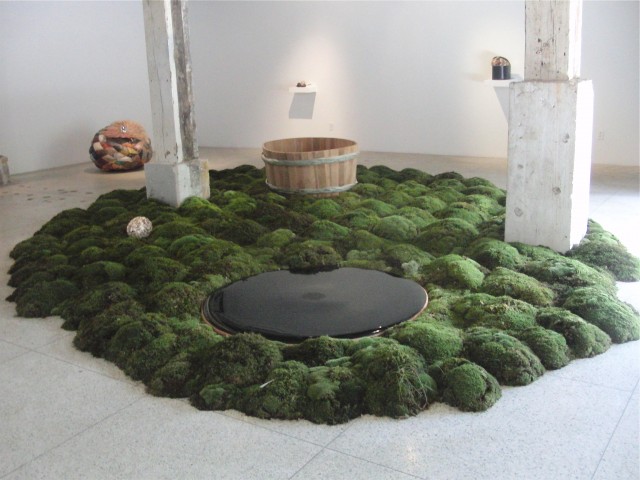
Honey Space says goodbye to Chelsea with an exhibit featuring living grass (photo by twi-ny/mdr)
twi-ny: Over the five-plus years you were here, you often transformed the space. How would you say it transformed you, both as an artist and a person?
Thomas Beale: In so many ways. After Honey Space, my life as an artist is something entirely different, and at the same time, not at all dissimilar from what it was before. Collaborating with other artists to flesh out their visions is something I’ll take a lot away from — both in my own exhibition-making and other curating I may do in the future. I learned how hungry people are for the radical gesture, how humanizing it is for so many people . . . the pleasure you can take from doing something independently . . . and that old truism that what you put out into the world will be returned back to you.
twi-ny: Is there anything you can reveal about your new space in Brooklyn? Will you attempt something similar to what went on at Honey Space, or are you planning something different?
Thomas Beale: Someone is offering me another rent-free studio for a period of time, but I only plan to use it to create my own work. Honey Space was interesting to me because it was in the middle of Chelsea, something so unlikely, that could look and feel so different from the rest of Chelsea, and the freedom I had here allowed me to do things that would resonate in contrast. I imagine that I will curate other exhibitions sometime again in the future, but for the immediate term, I’m excited to dive into my own creative practice.
twi-ny: Will there be a final blow-out for Honey Space, or will it be a quiet farewell?
Thomas Beale: Thursday, September 27, 8:00 to midnight, “A Feast of Friends.” Three bands and a DJ friend who have all been a close part of family of this space will be performing. It will not be quiet.
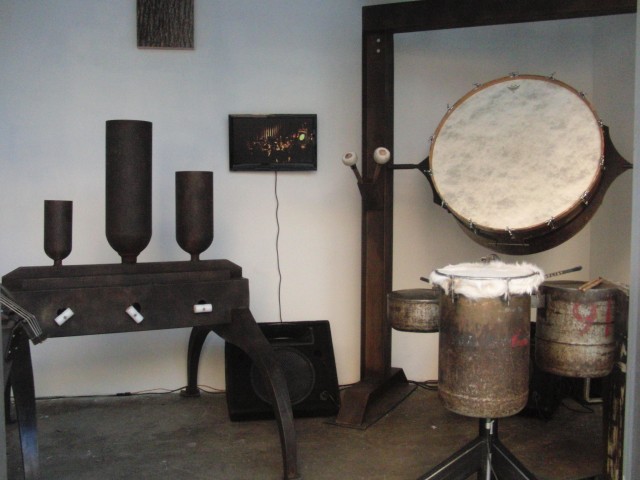

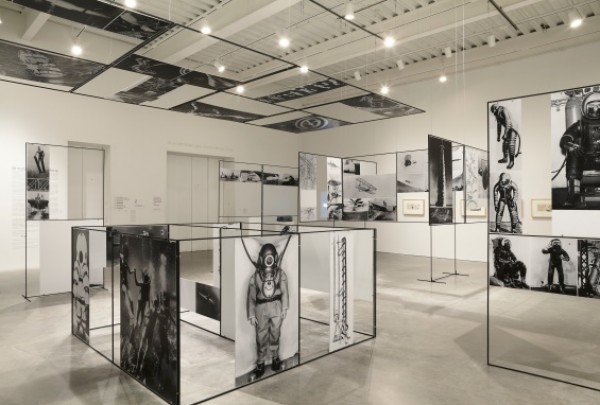
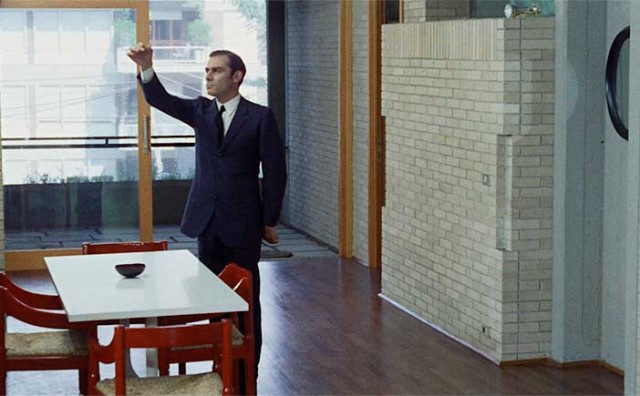
 As Investigation of a Citizen Above Suspicion begins, a man (Gian Maria Volontè) kills a woman (Florinda Bolkan) in the midst of some rather kinky sex. The man then goes out of his way to leave behind evidence tying him to the brutal crime, including making sure he is spotted as he exits the woman’s building complex. It is soon revealed that he is the former head of homicide in Rome who has just been promoted to chief of political intelligence, his victim a married lover of his who enjoyed acting out real murder cases with him. “How will you kill me this time?” she asks in a flashback, not knowing where their games will ultimately lead. For the rest of Elio Petri’s (A Quiet Place in the Country) absurdist farce, the man practically dares his colleagues to catch him as he continues to build a case against himself and rails against criminal and political terrorists and subversives in neo-fascist romps, filmed in daring close-up, that emphasize the importance of keeping the masses repressed. Shot in broad colors and featuring a playful score by Ennio Morricone, Investigation of a Citizen Above Suspicion is an enticing police procedural — in which the culprit is the man in charge of the case — as well as a satiric look at the state of Italian politics in 1970, as social unrest and sexual freedom grew throughout Europe and America. “Repressing all those evils is to cure them,” the man declares in a fiery speech to his department. Volontè (A Fistful of Dollars, For a Few Dollars More) clearly has a ball as a man who either wants to be caught or is out to prove that he is indeed above the law, Petri carefully keeping his motive ambiguous in this wonderful black comedy. Winner of the Oscar for Best Foreign Language Film and the Grand Prize at Cannes, Investigation of a Citizen Above Suspicion will be screening in a new DCP restoration at Film Forum September 28 through October 4, with Sony restoration expert Grover Crisp on hand to introduce the 7:30 screening on opening night.
As Investigation of a Citizen Above Suspicion begins, a man (Gian Maria Volontè) kills a woman (Florinda Bolkan) in the midst of some rather kinky sex. The man then goes out of his way to leave behind evidence tying him to the brutal crime, including making sure he is spotted as he exits the woman’s building complex. It is soon revealed that he is the former head of homicide in Rome who has just been promoted to chief of political intelligence, his victim a married lover of his who enjoyed acting out real murder cases with him. “How will you kill me this time?” she asks in a flashback, not knowing where their games will ultimately lead. For the rest of Elio Petri’s (A Quiet Place in the Country) absurdist farce, the man practically dares his colleagues to catch him as he continues to build a case against himself and rails against criminal and political terrorists and subversives in neo-fascist romps, filmed in daring close-up, that emphasize the importance of keeping the masses repressed. Shot in broad colors and featuring a playful score by Ennio Morricone, Investigation of a Citizen Above Suspicion is an enticing police procedural — in which the culprit is the man in charge of the case — as well as a satiric look at the state of Italian politics in 1970, as social unrest and sexual freedom grew throughout Europe and America. “Repressing all those evils is to cure them,” the man declares in a fiery speech to his department. Volontè (A Fistful of Dollars, For a Few Dollars More) clearly has a ball as a man who either wants to be caught or is out to prove that he is indeed above the law, Petri carefully keeping his motive ambiguous in this wonderful black comedy. Winner of the Oscar for Best Foreign Language Film and the Grand Prize at Cannes, Investigation of a Citizen Above Suspicion will be screening in a new DCP restoration at Film Forum September 28 through October 4, with Sony restoration expert Grover Crisp on hand to introduce the 7:30 screening on opening night.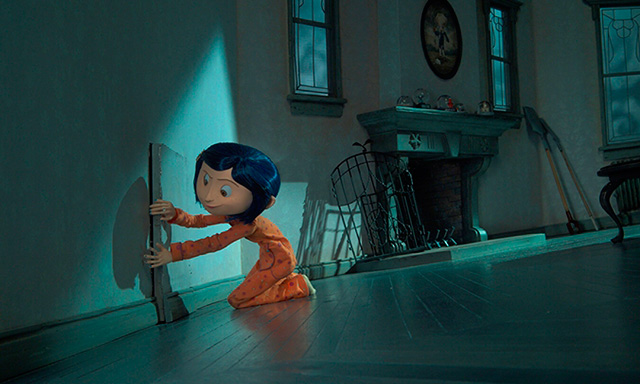
 Coraline Jones (voiced by Dakota Fanning) is an adventurous eleven-year-old in search of some fun and excitement in her new creaky home in Oregon. She finds just what she thinks she was looking for when a rodent introduces her to a hidden passageway that leads to an alternate universe, where replicas of her parents (Teri Hatcher and John Hodgman) are more interested in her and give her whatever she wants. However, this button-eyed Other Mother and Other Father have other plans for her and her real family as well. Written and directed by Henry Selick, Coraline lacks the frantic, nonstop energy of his breakthrough film, Tim Burton’s The Nightmare Before Christmas, but it is still a fun, creepy trip down the Narnia-esque rabbit hole. Combining his trademark stop-motion animation (James and the Giant Peach) with breathtaking stereoscopic 3-D that adds remarkable depth to the images, Selick does a marvelous job bringing to life the popular children’s novel by Newbery Medal-winning author Neil Gaiman (Sandman), who wrote the book for his young daughters. (Full disclosure: In another part of our life, we work for the company that publishes Gaiman’s children’s books, including Coraline.) The supporting cast of characters includes former music-hall divas Miss Spink and Miss Forcible (the Absolutely Fabulous British comedy team of Jennifer Saunders and Dawn French), the wise Cat (Keith David), mouse circus leader Mr. Bobinsky (Ian McShane), and local boy Wybie Lovat (Robert Bailey Jr.), who was created specifically for the movie. Be sure to stick around for one last cool 3-D effect at the end of the credits. Coraline is screening on September 28 and 29 at 1:00 as part of the Museum of the Moving Image’s “Film After Film” series, a collection of works selected by J. Hoberman focusing on how digital technology is changing the way movies are both made and viewed.
Coraline Jones (voiced by Dakota Fanning) is an adventurous eleven-year-old in search of some fun and excitement in her new creaky home in Oregon. She finds just what she thinks she was looking for when a rodent introduces her to a hidden passageway that leads to an alternate universe, where replicas of her parents (Teri Hatcher and John Hodgman) are more interested in her and give her whatever she wants. However, this button-eyed Other Mother and Other Father have other plans for her and her real family as well. Written and directed by Henry Selick, Coraline lacks the frantic, nonstop energy of his breakthrough film, Tim Burton’s The Nightmare Before Christmas, but it is still a fun, creepy trip down the Narnia-esque rabbit hole. Combining his trademark stop-motion animation (James and the Giant Peach) with breathtaking stereoscopic 3-D that adds remarkable depth to the images, Selick does a marvelous job bringing to life the popular children’s novel by Newbery Medal-winning author Neil Gaiman (Sandman), who wrote the book for his young daughters. (Full disclosure: In another part of our life, we work for the company that publishes Gaiman’s children’s books, including Coraline.) The supporting cast of characters includes former music-hall divas Miss Spink and Miss Forcible (the Absolutely Fabulous British comedy team of Jennifer Saunders and Dawn French), the wise Cat (Keith David), mouse circus leader Mr. Bobinsky (Ian McShane), and local boy Wybie Lovat (Robert Bailey Jr.), who was created specifically for the movie. Be sure to stick around for one last cool 3-D effect at the end of the credits. Coraline is screening on September 28 and 29 at 1:00 as part of the Museum of the Moving Image’s “Film After Film” series, a collection of works selected by J. Hoberman focusing on how digital technology is changing the way movies are both made and viewed.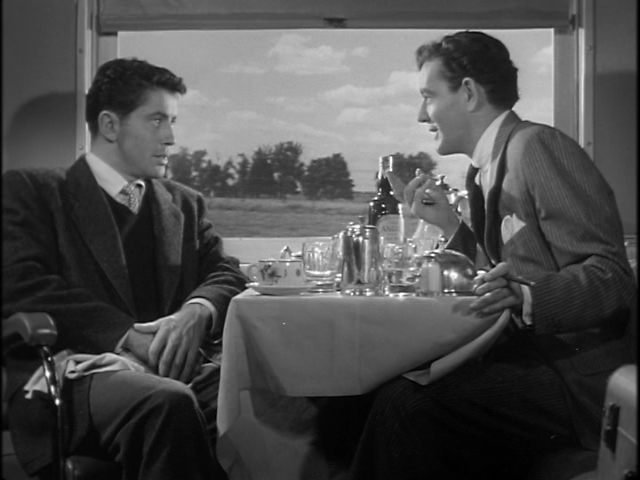
 The Rubin Museum’s Cabaret Cinema series “Happiness Is . . .” continues with one of Alfred Hitchcock’s most multilayered, complex tales, the 1951 psychological double-murder thriller Strangers on a Train. Shortly after introducing himself to amateur tennis star Guy Haines (Farley Granger) on a train, mama’s boy Bruno Anthony (an appropriately creepy Robert Walker) concocts a supposedly foolproof plan in which Bruno will kill Guy’s unfaithful wife, Miriam (Laura Elliott), so Guy can marry his socialite girlfriend, Anne Morton (Ruth Roman), one of the daughters of a U.S. senator (Leo G. Carroll). In return, Guy will kill Bruno’s father (Jonathan Hale). Bruno believes he has devised the perfect crisscross murder, with neither man having a clear motive and nothing for the cops to find to link them together. While Bruno is serious, Guy thinks he’s just a loon (Walker had in fact been recently released from a psychiatric clinic after suffering a nervous breakdown and died at the age of thirty-two before the film even opened), but after the psychopathic Bruno actually does kill Miriam — photographed in an unforgettable way by cinematographer Robert Burks, shown in a pair of broken eyeglasses — he starts shadowing Guy, insisting he keep his part of the bargain and kill Mr. Anthony, something Guy never intended on doing. Soon the cops are involved, along with a broken alibi, a key, and a critical cigarette lighter, leading to a spectacular conclusion on a merry-go-round. Loosely based on Patricia Highsmith’s debut novel and featuring an early screenplay written by Raymond Chandler (whose name was kept in the credits for marquee value despite Hitchcock’s famous — and literal — trashing of his contribution), Strangers on a Train is a powerful, tense mystery built around the idea of the double; from the opening scene of two pairs of shoes — immediately equating, and differentiating between, the two protagonists, as if they were two parts of the same person — to Hitchcock’s appearance carrying a double bass, to Anne’s younger sister, Babs (Patricia Hitchcock, Alfred’s daughter), wearing the same glasses as Miriam, to Bruno’s declaration, upon ordering two double scotches and relating them to tennis, “The only kind of doubles I play,” the film is filled with mirroring or directly opposing elements. As with Hitchcock’s Rope, which also starred Granger, Strangers on a Train also has a clear homosexual subtext; in real life Walker was straight while Granger was bisexual. Shot in a dark black-and-white that adds to the chilling effects, Strangers on a Train is one of Hitchcock’s best, a fully realized, frightening film that ends in a big way. The Rubin Museum screening on September 29 will be introduced by chef and musician Molly Neuman. “All in all,” Granger wrote in his 2007 autobiography, Include Me Out: My Life from Goldwyn to Broadway, “working on Strangers on a Train was my happiest filmmaking experience,” giving it extra reason to be included in this series that looks at different kinds of happiness in the movies.
The Rubin Museum’s Cabaret Cinema series “Happiness Is . . .” continues with one of Alfred Hitchcock’s most multilayered, complex tales, the 1951 psychological double-murder thriller Strangers on a Train. Shortly after introducing himself to amateur tennis star Guy Haines (Farley Granger) on a train, mama’s boy Bruno Anthony (an appropriately creepy Robert Walker) concocts a supposedly foolproof plan in which Bruno will kill Guy’s unfaithful wife, Miriam (Laura Elliott), so Guy can marry his socialite girlfriend, Anne Morton (Ruth Roman), one of the daughters of a U.S. senator (Leo G. Carroll). In return, Guy will kill Bruno’s father (Jonathan Hale). Bruno believes he has devised the perfect crisscross murder, with neither man having a clear motive and nothing for the cops to find to link them together. While Bruno is serious, Guy thinks he’s just a loon (Walker had in fact been recently released from a psychiatric clinic after suffering a nervous breakdown and died at the age of thirty-two before the film even opened), but after the psychopathic Bruno actually does kill Miriam — photographed in an unforgettable way by cinematographer Robert Burks, shown in a pair of broken eyeglasses — he starts shadowing Guy, insisting he keep his part of the bargain and kill Mr. Anthony, something Guy never intended on doing. Soon the cops are involved, along with a broken alibi, a key, and a critical cigarette lighter, leading to a spectacular conclusion on a merry-go-round. Loosely based on Patricia Highsmith’s debut novel and featuring an early screenplay written by Raymond Chandler (whose name was kept in the credits for marquee value despite Hitchcock’s famous — and literal — trashing of his contribution), Strangers on a Train is a powerful, tense mystery built around the idea of the double; from the opening scene of two pairs of shoes — immediately equating, and differentiating between, the two protagonists, as if they were two parts of the same person — to Hitchcock’s appearance carrying a double bass, to Anne’s younger sister, Babs (Patricia Hitchcock, Alfred’s daughter), wearing the same glasses as Miriam, to Bruno’s declaration, upon ordering two double scotches and relating them to tennis, “The only kind of doubles I play,” the film is filled with mirroring or directly opposing elements. As with Hitchcock’s Rope, which also starred Granger, Strangers on a Train also has a clear homosexual subtext; in real life Walker was straight while Granger was bisexual. Shot in a dark black-and-white that adds to the chilling effects, Strangers on a Train is one of Hitchcock’s best, a fully realized, frightening film that ends in a big way. The Rubin Museum screening on September 29 will be introduced by chef and musician Molly Neuman. “All in all,” Granger wrote in his 2007 autobiography, Include Me Out: My Life from Goldwyn to Broadway, “working on Strangers on a Train was my happiest filmmaking experience,” giving it extra reason to be included in this series that looks at different kinds of happiness in the movies.
